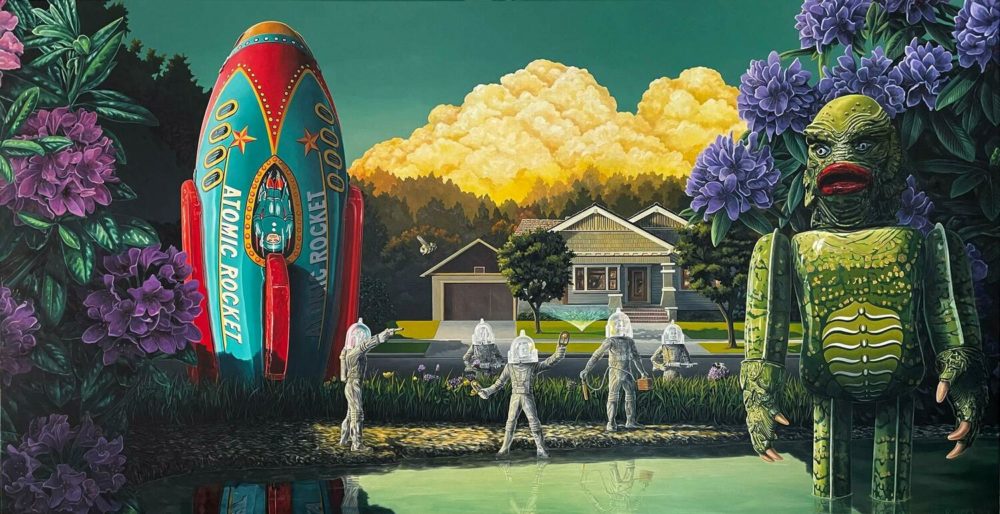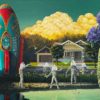Ross Jones
Extinction
Oil on Fine Portrait Linen
950 x 1800 mm
$42,000
Available
The creature, the last of its kind, flees its pursuers. Are the spacemen there to study or to destroy?
The spectre of extinction, a crisis that reflects humanity’s profound impact on the environment, is not a distant threat but a pressing issue. According to the International Science-Policy Platform on Biodiversity and Ecosystem Services (IPBES), over a million animal and plant life species are now threatened with extinction – an unprecedented number in human history. This staggering statistic underscores the urgent need to reassess our relationship with the natural world and its creatures. The time for action is now.
Extinction is not just the loss of individual species but also of the intricate web of life-supporting ecosystems and human survival. Each species, no matter how small or seemingly insignificant, plays a unique role in its environment, contributing to processes such as pollination, seed dispersal, and climate and disease regulation. When a species disappears, these processes can be disrupted, leading to cascading effects that threaten other species and even human populations. This interconnectedness underscores the gravity of the extinction crisis, making it a global issue that demands immediate attention and action.
The discovery of a new species, a rare and increasingly precious event, holds the potential to reshape our understanding of the world and ignite our curiosity. It serves as a reminder that the natural world is vast and largely unexplored, with many secrets still waiting to be uncovered. However, discovering new species also raises important ethical questions about how we interact with these creatures. Whether we study them from a distance, cage and confine them, or destroy them out of fear, our actions reflect our attitudes toward the natural world and our place within it.
Human activities such as deforestation, pollution, and climate change are driving species to extinction at an alarming rate. The destruction of habitats, particularly in biodiversity hotspots like rainforests and coral reefs, leaves species with nowhere to go. At the same time, climate change alters the conditions necessary for their survival. Moreover, the introduction of invasive species, overhunting, and the illegal wildlife trade further accelerate the decline of vulnerable species.
The consequences of extinction are far-reaching and irreversible. The loss of biodiversity diminishes ecosystem resilience, making them more susceptible to shocks and unable to provide essential services. It also represents a loss of cultural and scientific knowledge, as many species hold significance in indigenous traditions and have potential applications in medicine, agriculture, and other fields. This irreversibility underscores the need for prevention, making it crucial to protect vulnerable species.
Ultimately, the extinction crisis reflects our broader relationship with the natural world. It challenges us to rethink our priorities and recognise the intrinsic value of all living things. Protecting species from extinction is not just about preserving the past; it is about securing the future for generations to come. By conserving biodiversity, we can ensure that the planet remains vibrant and diverse, full of life and possibility.
Our choices today will determine the fate of millions of species and the health of the planet as a whole. The discovery of a new species reminds us of the wonders that still exist in the natural world; still, it also serves as a call to action. We must choose to protect and preserve the rich tapestry of life on earth for our sake and the sake of all living creatures.
The heroes and villains featured in my painting ‘Extinction’ are Masuday Cragstan Horikawa’s 1950s Atomic Rocket, Marx’s 4-inch Spacemen, and The Creature Clockwork Robot (1991).
-Ross Jones
Ross Jones is a contemporary painter creating works that evoke a heady sense of nostalgia and elevated playfulness.
Working from his studio overlooking the Hauraki Gulf north of Auckland, Jones’ fusion of playful realism incorporates elements of the surreal. Each meticulously devised painting offers hints at various narratives as the artist invites the viewer to engage with his role as storyteller.
“I love the phrase “Don’t let the truth get in the way of a good story,” so as you view my paintings, don’t let your imagination stop you from seeing the bigger picture. How far the journey takes you is entirely up to you.” – Ross Jones









